TechRadar Verdict
This gaming PC proves size doesn’t matter. More powerful than most full-sized gaming desktops, this 12-liter package decimates 4K games. Just be sure to watch how hot the CPU gets.
Pros
- +
Incredible gaming performance
- +
No gaming desktop is this small
- +
Improved upgradability and airflow
Cons
- -
CPU gets very hot
- -
Replacing main SSD still a pain
Why you can trust TechRadar
The Corsair One i160 is a gaming PC like none other. Despite this being the third iteration of the component maker’s miniature gaming desktop, no other company has come close to making something nearly as compact, fully liquid-cooled or silent.
This year, the Corsair One i160 has been upgraded with the best consumer processor money can buy, the Intel Core i9-9900K, loaded out with top-end Nvidia GeForce RTX 2080 Ti graphics and, of course, RGB lighting.
Despite asking for a kingly sum, we’re confident this gaming PC is worth the expense – just be aware that processor performance suffers in such a tight enclosure.
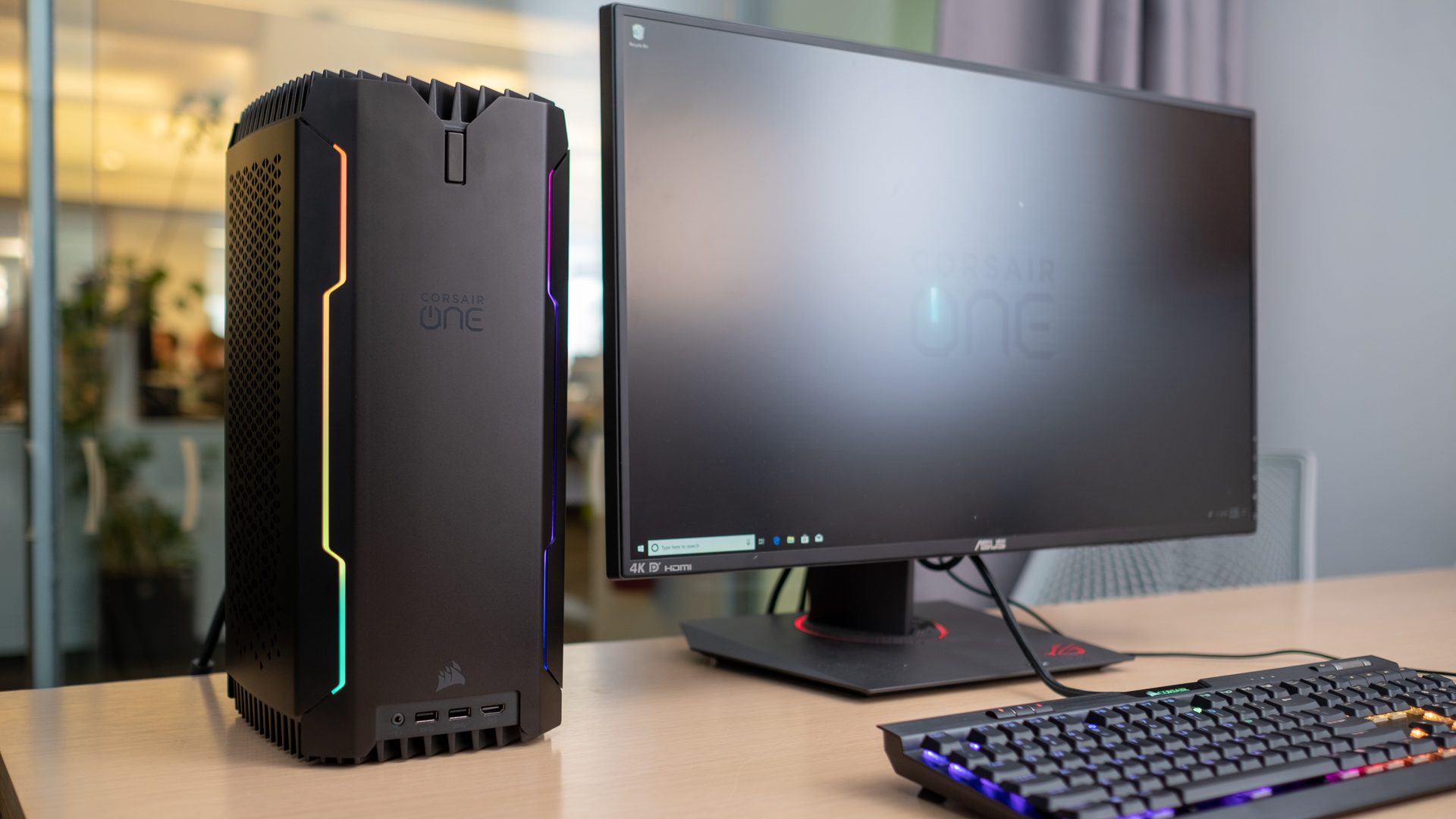
Here is the Corsair One i160 configuration sent to TechRadar for review:
CPU: 3.6GHz Intel Core i9-9900K (octa-core, 16MB cache, up to 5.0GHz)
Graphics: MSI GeForce RTX 2080 Ti (11GB GDDR6 VRAM); Intel UHD Graphics 630
RAM: 32GB (2 x 16GB) Corsair Vengeance LPX DDR4-2666
Motherboard: Intel Z370
Power Supply: Corsair SF600
Storage: 480GB M.2 NVMe SSD, 2TB HDD (7,200 rpm)
Ports (front): 2x USB 3.1 Gen 1, HDMI 2.0, Combination Mic/Headphone Jack
Ports (rear): Rear: PS/2, 2x USB 2.0, USB 3.1 Gen 2 Type-C, USB 3.1 Gen 2 Type-A, 2x USB 3.1 Gen 1, 7.1 Surround Audio, 3x DisplayPort
Connectivity: 802.11ac 2x2 Wi-Fi, Bluetooth
Operating system: Windows 10
Weight: 16.3 pounds (7.38kg)
Size: 7.9 x 7 x 15 inches (20 x 17.6 x 38cm; W x D x H)
Pricing and availability
The new Corsair One series is expensive to be sure, with the starting model priced at $2,999 or £2,849 (about AU$4,180). This Corsair One i140 configuration nets you an Intel Core i7-9700K processor, Nvidia GeForce RTX 2080 graphics card, 32GB of memory, plus a 480GB SSD backed up by a 2TB hard drive.
What makes the pricing interesting is that this base model costs as much as the highest-end, last-generation Corsair One Elite equipped with an Intel Core i7-8700K CPU and Nvidia GeForce GTX 1080 Ti GPU.
This configuration you see to the right is our review unit, the mid-range Corsair One i160 model, includes the best consumer-grade gaming hardware you can ask for today.
Another model up, the Corsair One i180 throws on a 14-core, 28-thread Intel Core i9-9940X processor designed for media production-level workloads. This last model releases on February 12 and will cost a stratospheric $4,999 or £4,749 (about AU$6,975).
Sign up for breaking news, reviews, opinion, top tech deals, and more.
Across its extreme price range, the new Corsair One faces several strong rivals but always comes out on top with better hardware for a noticeably higher price. The base i140 butts heads with the $2,299 (about £1,800, AU$3,150) MSI Trident X that features an Intel Core i7-9700K, Nvidia RTX 2080, 16GB of RAM and 256GB SSD.
Meanwhile, the $3,299 or £2,499 (about AU$4,520) Asus ROG Strix GL12CX faces off with the Corsair One i160 with an Intel Core i9-9900K, an Nvidia RTX 2080, 16GB of memory and only 256GB of SSD storage space.
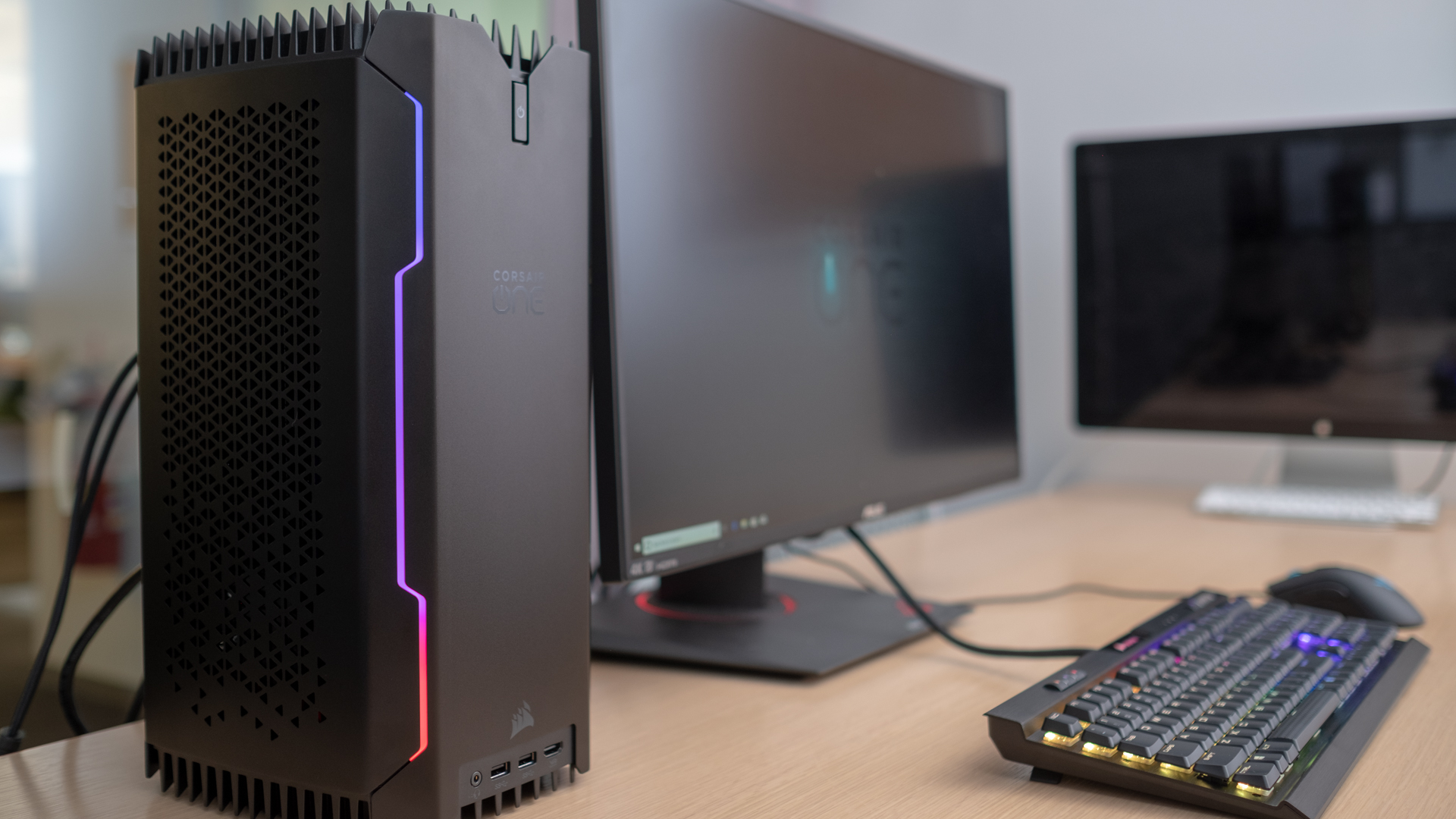

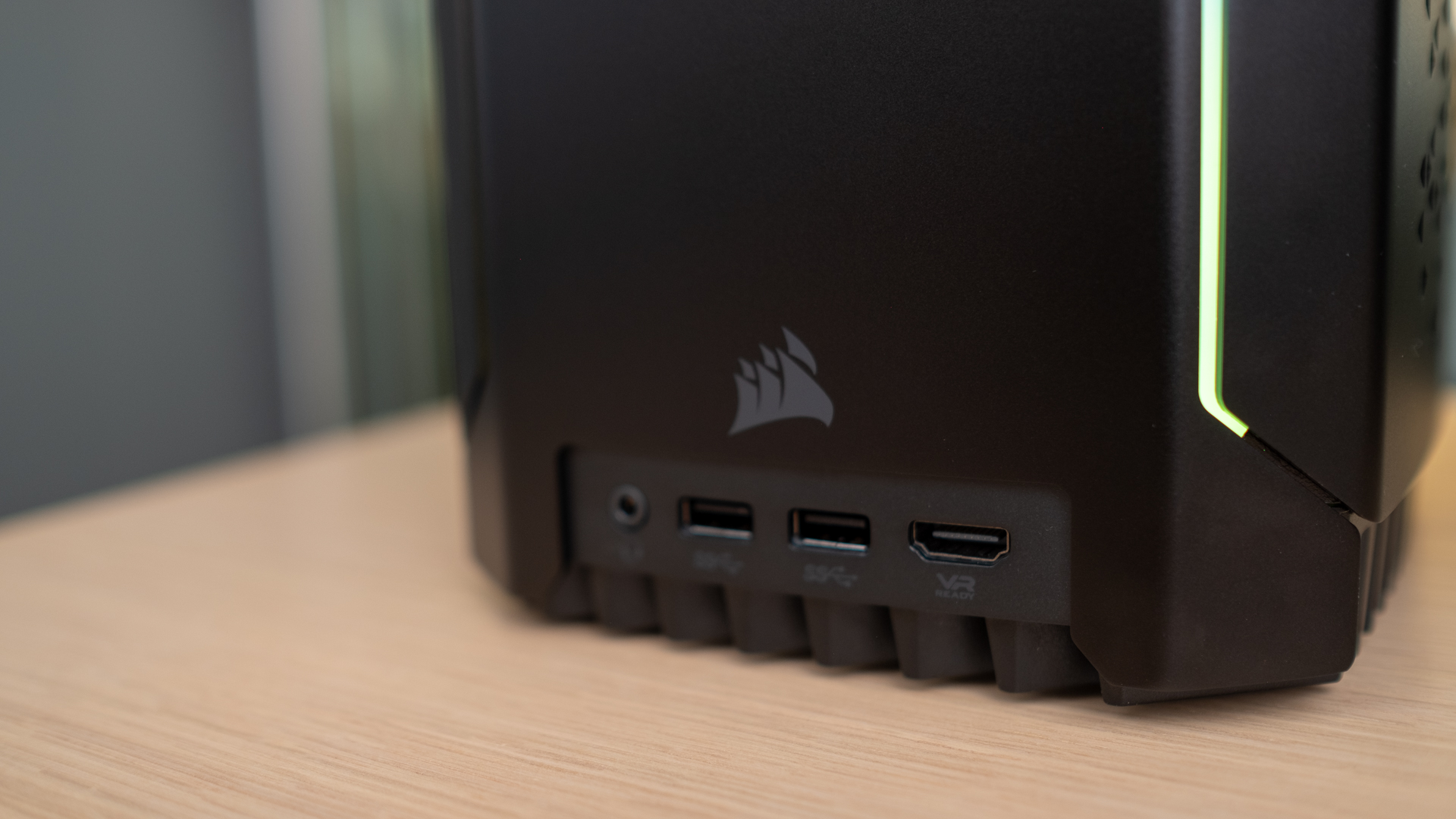
Design
The Corsair One i160 is a stunning gaming machine. Two-millimeter thin metal plates meet to create angular lines, and the top of the unit caps off with tall, diagonal fins. The unit’s entire chassis looks beyond modern, and its thin lighting lanes only help accentuate this aesthetic with callbacks to Tron.
Between the Corsair One i160’s aluminum exterior and steel internal frame – not to mention all the densely packed components, the unit feels like it has the density of dark matter. If it weren’t for its obvious PC connections, we could have mistaken this for a high-yield warhead for a photon torpedo.
Although the Corsair One i160 might look exactly like the Corsair One Elite that came before it, there are a few new bells and whistles on this mini gaming PC. For starters, this miniature rig gains RGB lighting on its front façade, whereas the previous models only had blue lights that could only be programmed to customizable patterns.
Secondly, you might notice that the lattice of ventilation holes along the sides now span across the entire sides of the desktop. This, of course, is there to accommodate more airflow for the PC’s full-sized, liquid-cooled radiators.

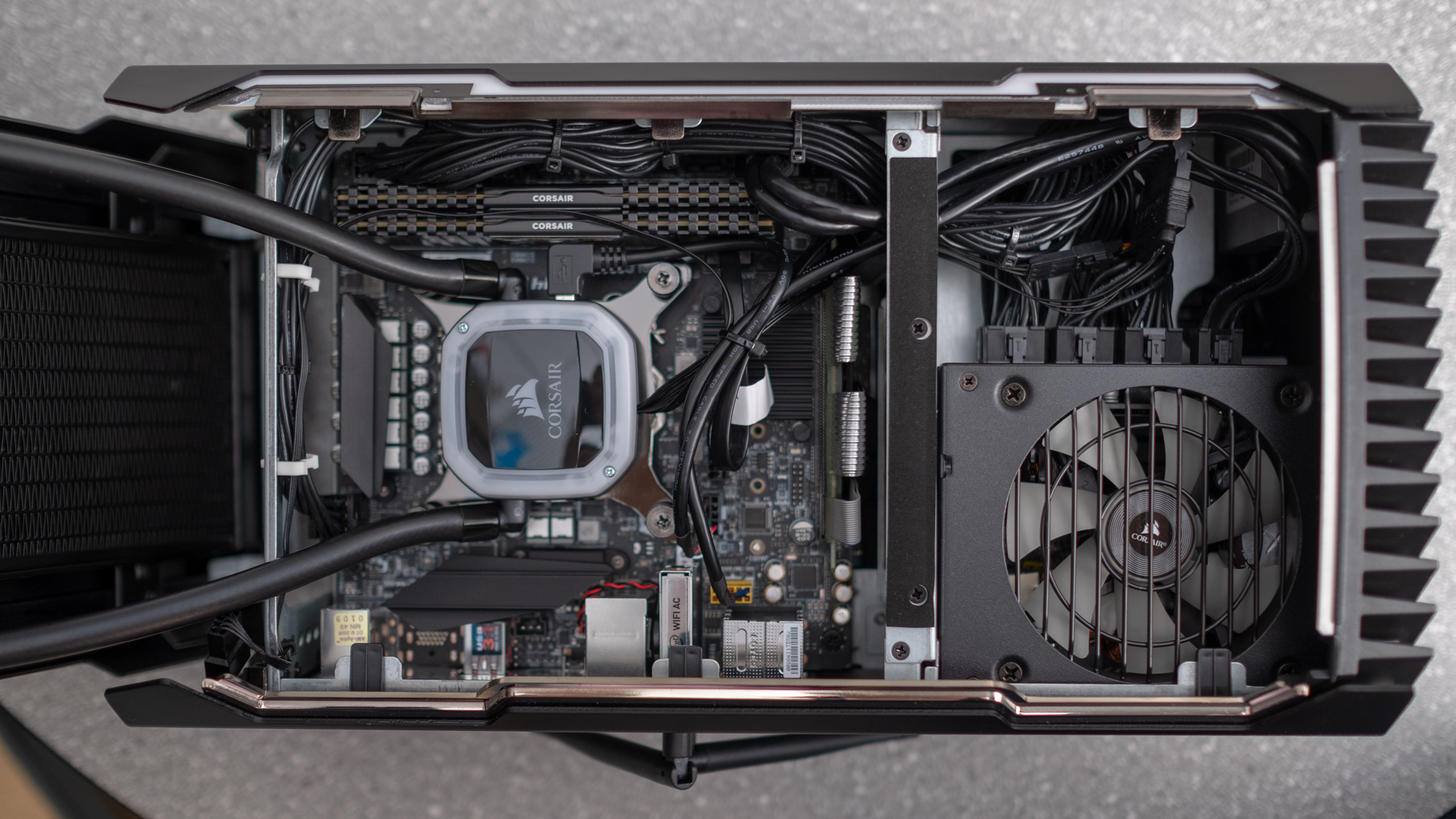
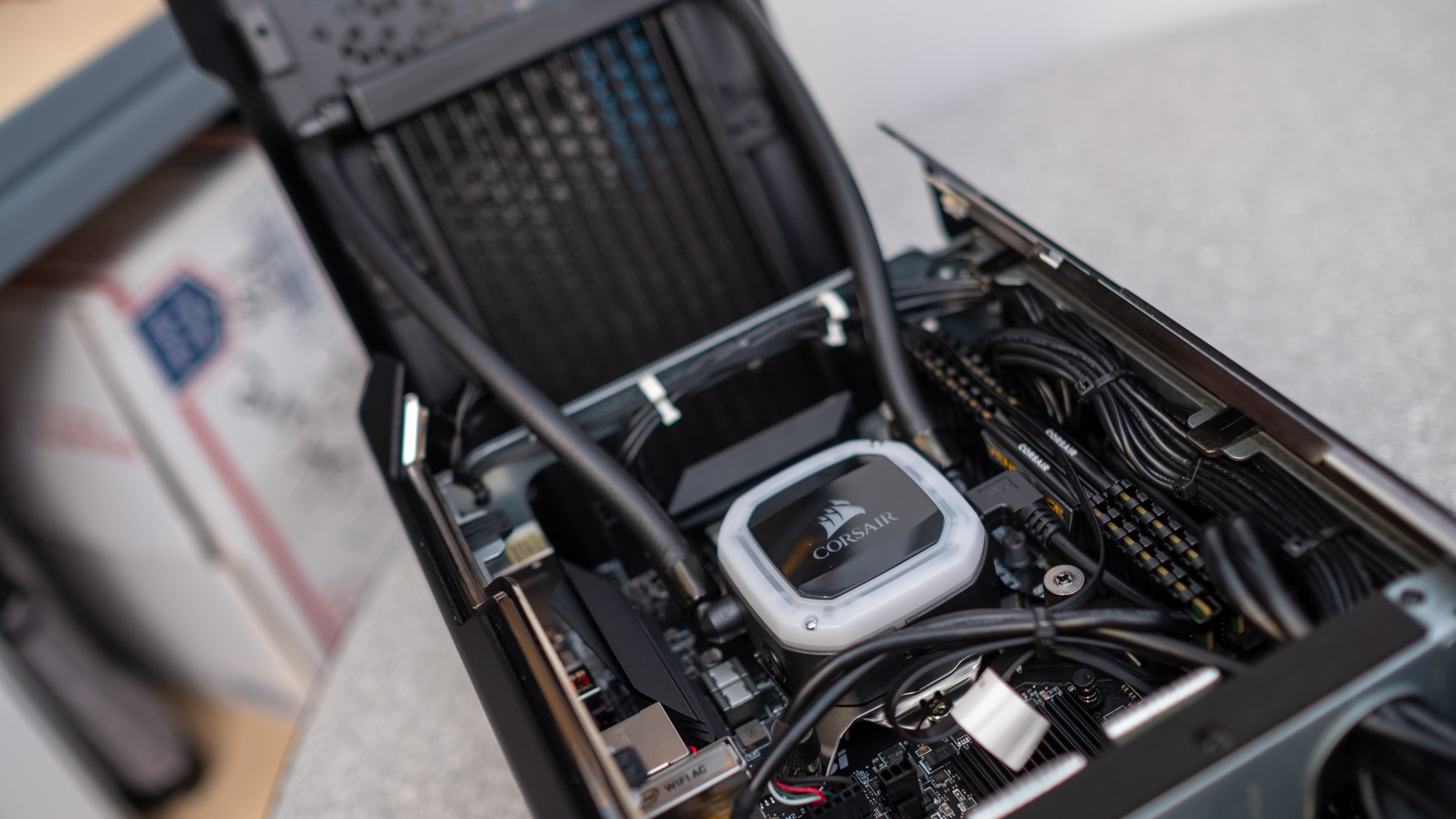
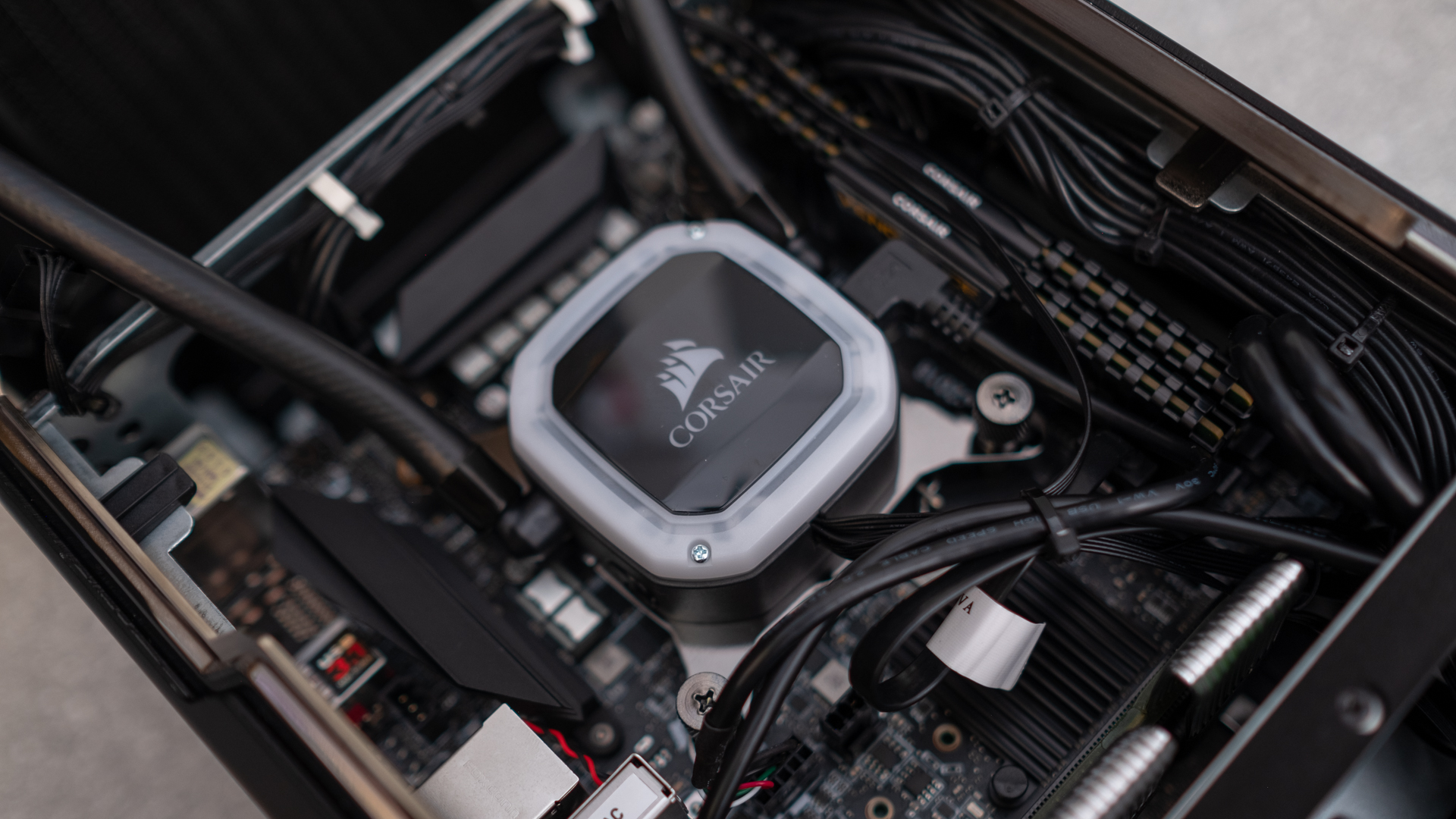

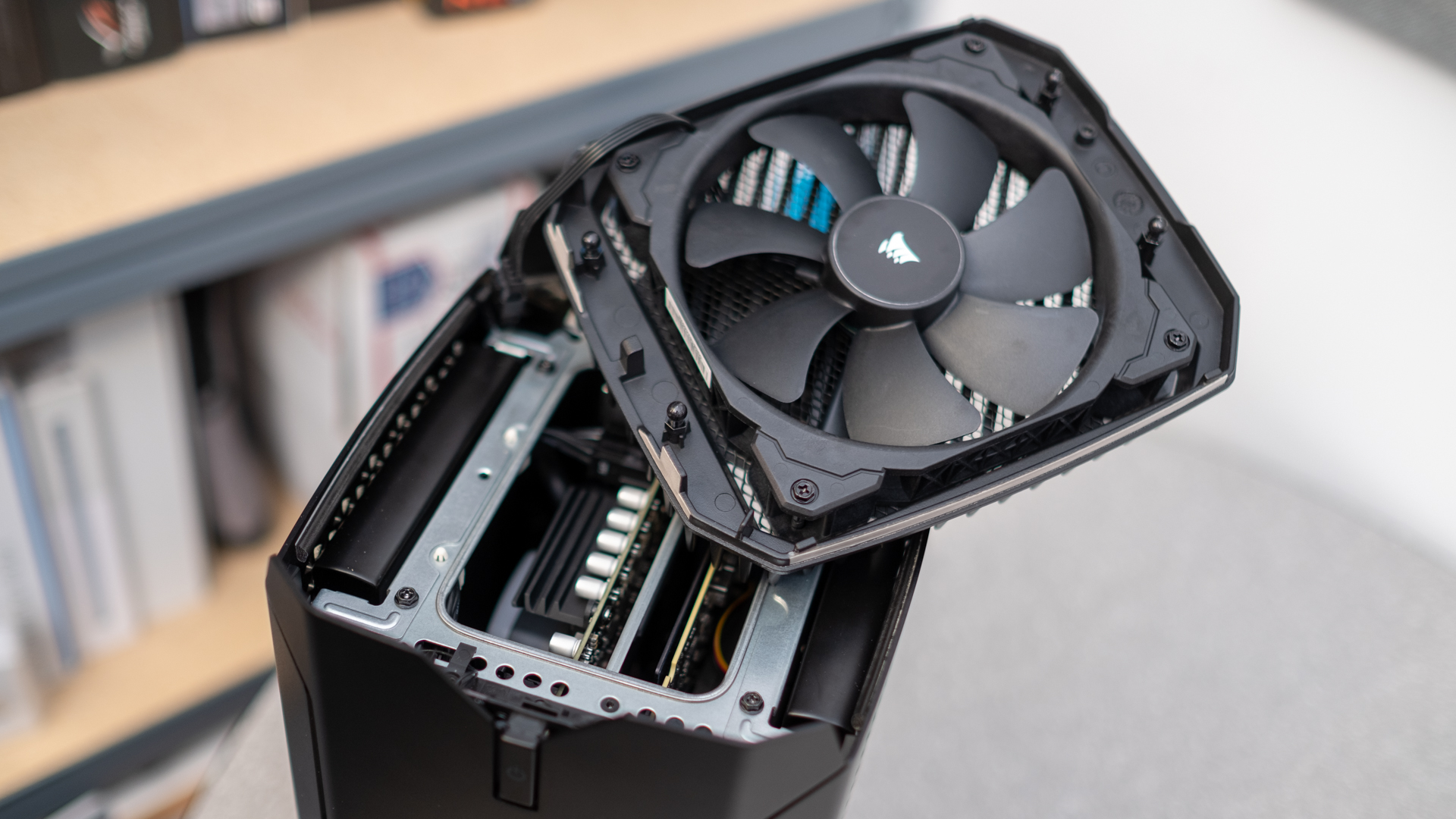

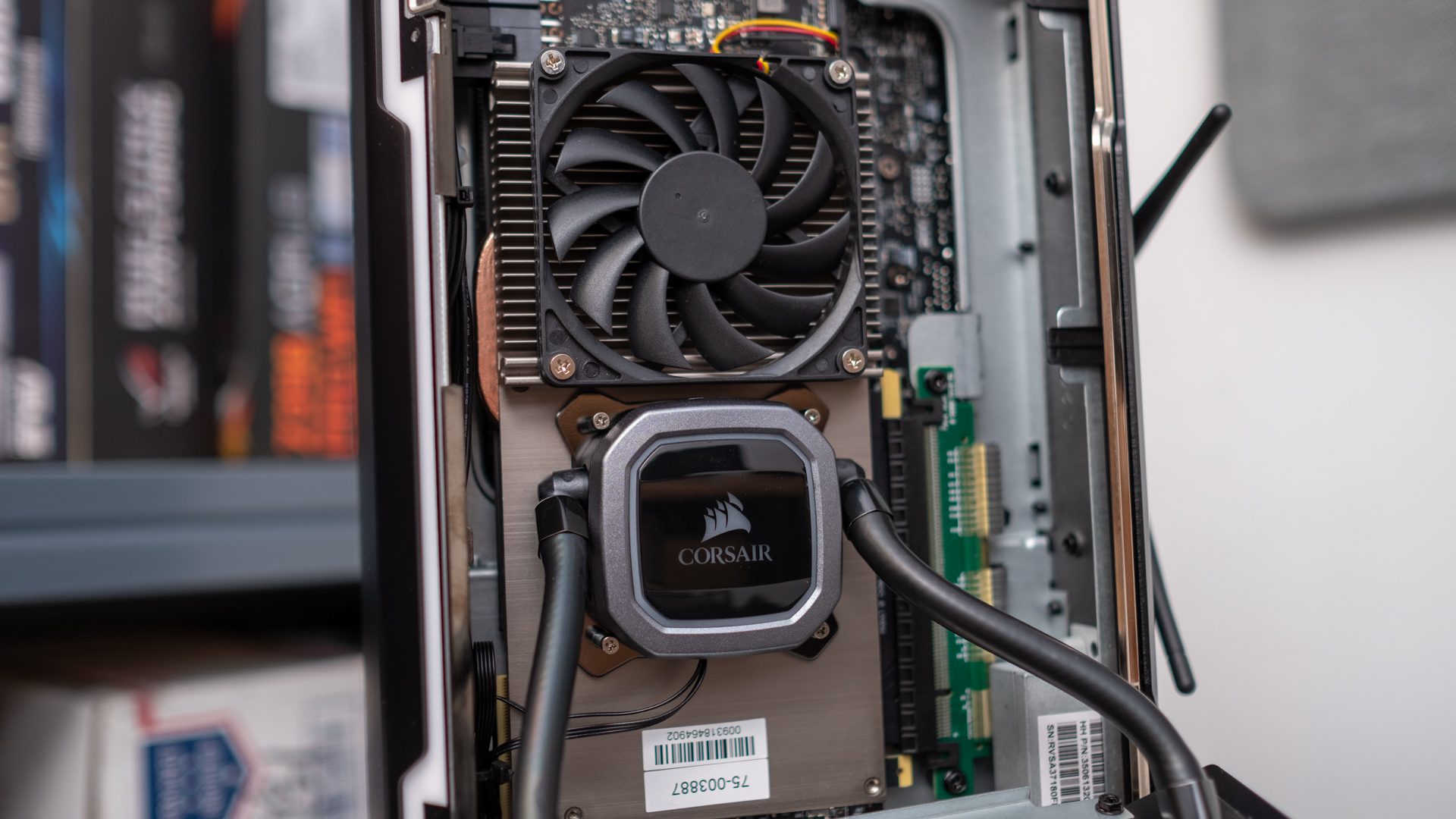
Upgradability
If anything, the Corsair One i160 has seen a much greater internal reshuffling with this refresh. The power supply has been moved from the top-right of the unit, where it sat on top of the graphics card, to the bottom-left of the case. This way, the PSU is better isolated from the two most heat-generating components.
Thanks to this redesign, it eliminates the one extension cable for power while shortening others necessary for video connections. The end result is a Corsair One i160 that is much more streamlined on the inside for better airflow.
Upgrading has also been made a little bit easier this time around. The hard drive has been relocated from the side of the PC to an easier-to-reach tray sandwiched between the Corsair One i160’s motherboard and power supply. The CPU is also easily accessible after removing the liquid-cooler pump. System memory is by far the easiest to remove and replace, as you only need to pop open the left side of the case and wiggle the RAM sticks out of their DIMM slots.
The only items that will be troubling to upgrade are the graphics card and the solid-state drive hidden behind it. The GPU is sheathed in a hybrid liquid/air cooler with the pump mounted onto the main GPU die while a separate fan and heat sink array sits on top of the video memory.
Still, Corsair claims users will be able to replace this part of its PC with any full-sized card that uses up to 300W of energy.

Here’s how the Corsair One i160 performed in our suite of benchmark tests:
3DMark: Sky Diver: 60,224; Fire Strike: 26,817; Time Spy: 13,516
Cinebench CPU: 1,861 points; Graphics: 175 fps
GeekBench: 6,086 (single-core); 32,955 (multi-core)
PCMark 8 (Home Test): 3,648 points
Total War: Warhammer II (1080p, Ultra): 96 fps; (1080p, Low): 220 fps
Shadow of the Tomb Raider (1080p, Ultra): 148 fps; (1080p, Low): 185 fps
Here’s how the Corsair One Elite performed in our suite of benchmark tests:
3DMark: Sky Diver: 49,733; Fire Strike: 22,596; Time Spy: 9,272
Cinebench CPU: 1,392; Graphics: 143.29fps
GeekBench: 5,365 (single-core); 23,290 (multi-core)
PCMark 8 (Home Test): 5,524
Total War: Warhammer: 315.3fps; (1080p, Low); 134.3fps (1080p, Ultra)
Middle Earth: Shadow of War: 96/183fps; (1080p, Low): 23/120fps (1080p, Ultra)
Performance
What a difference a generation of silicon makes. The Corsair One i160 completely outclasses the last generation Corsair One Elite – and, considering how much more it costs, it damn well better have.
Processing power is up, thanks to an Intel Core i9-9900K processor packing two additional cores. Meanwhile, graphical power has seen a bump up, thanks to Nvidia’s new all new Turing architecture, increases in frequency and adding faster GDDR6 memory.
Up against more contemporary gaming desktops, the Corsair One i160 also steamrolls over the MSI Trident X that maxes out with 24,522 point Geekbench and 10,021 point TimeSpy scores. Of course, MSI’s miniature desktop is running with lower power hardware that includes an Intel Core i7-9700K and Nvidia RTX 2080.
Unfortunately, the Corsair One i160’s winning streak is broken by the more comparable Asus ROG Strix GL12CX that scores a much higher 34,444 points on GeekBench and 2,027 points in Cinebench using the same Intel Core i9-9900K CPU.
From what we can tell, it seems that the Corsair One i160 simply can’t push its processor as hard as a traditionally-sized gaming desktop can. In fact, during our testing, we saw CPU temperatures inside the miniature PC reach up to 86C. The Corsair One i160 does a much better job of keeping its GPU running at a cooler 60C, thanks to a bigger radiator as well as a separate fan and heatsink attached to the card.

Going into Corsair’s iCUE performance and lighting tweaking software gives you some ability to adjust your system fan curves, but you can’t tell the liquid cooler to pump harder, sadly. Setting the Corsair One i160 to run at ‘Extreme’ performance mode spins the fans up to a maximum 1,467rpm. This helps the CPU stay 20-degrees Celsius cooler, but even in this mode we only saw a slight increase in processing performance.
Despite the limits the Corsair One i160 puts on the processor, we didn’t really see any degradation in our gaming experiences. The system still managed to run Battlefield V with HDR turned on, Ultra quality settings and Ultra RTX rendering at a playable 50 to 79 frames per second.
We also have to say the Corsair One i160 stays remarkably quiet even with its fan spinning at full tilt – of course, this desktop really only has one 140mm fan and a few other moving parts. That said, we wouldn’t mind if Corsair added a second, bottom-mounted intake fan to help alleviate this system’s cooling issues.
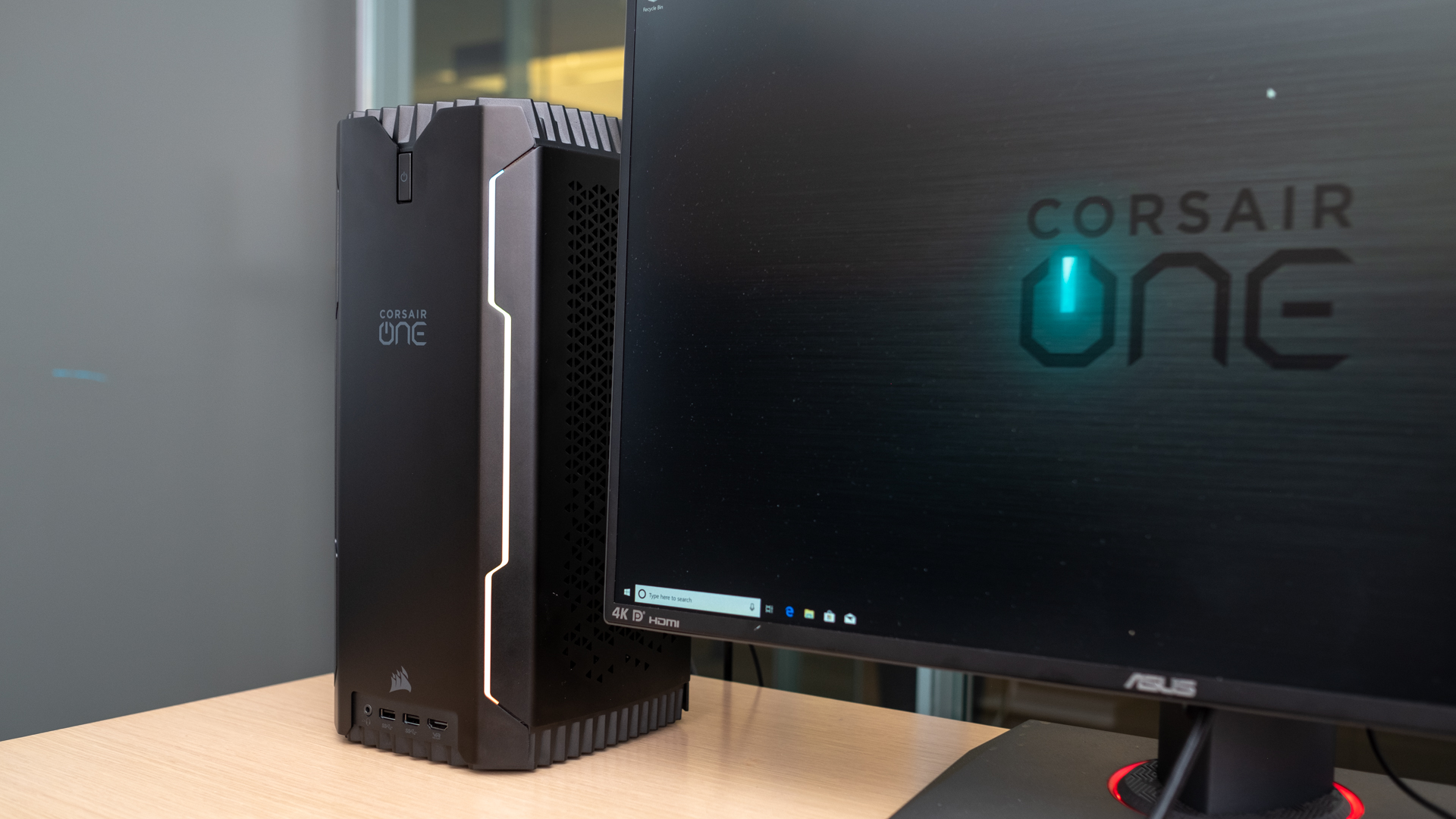
Final verdict
The Corsair One i160 is one of the most impressive gaming desktops we’ve ever reviewed, not only because of its compact size but also the unrelenting performance you can squeeze out of it. It’s a shame the CPU gets awfully hot, but we can’t really ask for much more cooling from a PC this compact. We also imagine users looking at this machine will just want a system to game on, and it handles all games with aplomb.
The Corsair One i160 might be expensive, but putting together a system with as many liquid-cooled components will set you back for about the same cost, and you’ll never be able to put together a gaming PC this small yourself. For these reasons, we recommend the Corsair One i160 if you’re looking for the tiniest, most performant gaming desktop money can buy.

Kevin Lee was a former computing reporter at TechRadar. Kevin is now the SEO Updates Editor at IGN based in New York. He handles all of the best of tech buying guides while also dipping his hand in the entertainment and games evergreen content. Kevin has over eight years of experience in the tech and games publications with previous bylines at Polygon, PC World, and more. Outside of work, Kevin is major movie buff of cult and bad films. He also regularly plays flight & space sim and racing games. IRL he's a fan of archery, axe throwing, and board games.
